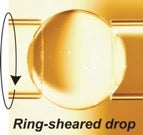By Amir Hirsa, professor of mechanical, aerospace, and nuclear engineering at Rensselaer
To paraphrase, when you’re a fluid mechanician, everything looks like a fluid mechanics problem. And so when a colleague, Prof. Georges Belfort, introduced me to the problem of protein amyloid fibrillization, some of my students and I became interested in understanding if and how amyloids are formed on the surface of flowing liquids. Amyloid fibrils play a key role in many neurodegenerative disorders, including Parkinson’s and Alzheimer’s disease, as well as other disorders such as Type 2 diabetes.
Aside from curiosity, the interest in studying amyloid fibril formation on aqueous surfaces stems from the fact that the air-water interface is hydrophobic—water-loving molecules want to avoid it and an oily material can preferentially collect there. Tissues also present lots of hydrophobic interfaces and as such can be understood and modeled as oily films on the surface of water.
A few years later, in response to a call from NASA for proposals to do research aboard the International Space Station (ISS) in the area of Complex Fluids and Macromolecular Biophysics, we did a little “out of the box” thinking. We literally shed the box/container and proposed to study the effects of hydrodynamic and interfacial stresses on generations of amyloid fibril structures in the absence of solid containers.

The NASA RSD project, now in its sixth year, is closer to coming to fruition. Significant amount of research has already been done on the ground—both in the laboratory and using computer simulations—and contractors for NASA Marshall Space Flight Center have already finished construction of the space hardware. The RSD module is now on the manifest for launch to the ISS aboard SpaceX-18 mission, due to launch in July 2019. The ground-based experiments have demonstrated a complex interplay between hydrodynamic stress in the bulk liquid and stress at the surface of the liquid.
In addition to myself, the Rensselaer team includes postdoc Adi Raghunandan and James Young ’12 (M.S., chemical engineering), ’13 (Ph.D., mechanical engineering), lecturer in mechanical, aerospace, and nuclear engineering.
P.S.: As it turns out, fluid flow is the key mechanism in transporting pre-fibril protein out of the brain (Nedergaard M “Garbage truck of the brain” Science 340, 1529-1530, 2013).
Listen as Hirsa discusses this project in an Academic Minute.





